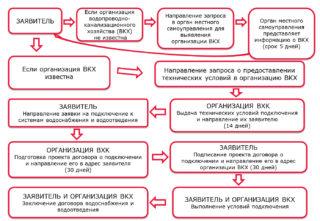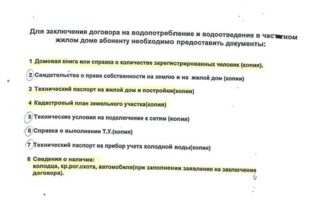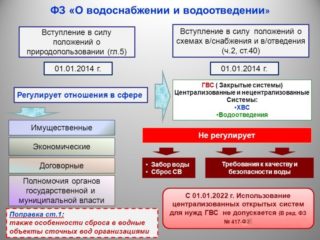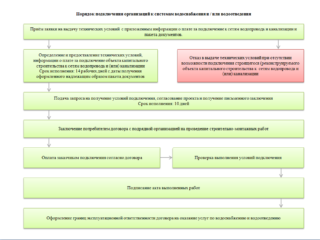The rules for cold water supply and sanitation regulate the relationship between the organization, which is engaged in the supply of water and sewage disposal, and consumers. The latter are residents of apartment buildings and private houses, manufacturing enterprises, companies and organizations of various types of activity.
The main provisions of the document

The process of supplying water and discharging sewage waste is based on a certain sequence of carrying out a number of steps. It is impossible to exclude at least one of them or violate the proposed sequence.
- It is necessary to obtain technical specifications. To do this, an application and several documents must be submitted to the organization that supplies water and drains sewage.
- A contract is being drawn up. The Federal Water Supply and Sanitation Act states that a consumer can enter into a contract with a service provider without previously obtained technical conditions. An agreement is the main document that defines the relationship between the two parties.
- According to the obtained technical conditions, installation work is carried out on the laying of water supply and sewerage systems. In this case, the service provider himself conducts the pipes to the place specified in the contract. Usually this is the border of the territory of the land plot. The rest of the pipes must be laid by the consumer at his own expense. In apartment buildings, this is the foundation of the building.
- An agreement is drawn up for connecting the water supply to the connection point, plus the provision of sanitary processing of the internal piping. Connection, flushing and disinfection are carried out by the service provider.
- An act is drawn up, which must be signed within 14 days after the completion of the connection and flushing. This document gives permission for the operation of water supply and sanitation.
- An agreement is being drawn up for the supply of water and the reception of sewage. It accurately indicates the volume of the supplied liquid (drinking or technical), its quality, as well as the tariff at which the consumer will pay for it. The contract specifies in one clause that the organization supplying water and draining sewage will purify the received water to the required state and discharge it further into water bodies.
If the technical conditions are received and the contract is drawn up, the consumer is given six months to connect to centralized networks. After this period, you will have to go through everything again. Therefore, during the construction of buildings and structures, first of all, internal engineering systems are carried out, they are connected to the central ones, and then they move on to the main construction processes.
Rules for obtaining permission
To obtain permission, you need to collect a package of documents. For private traders:
- copy of the person's passport;
- proof of ownership (land plot for construction, house);
- passports for water meters;
- the project according to which the meters will be installed;
- layout of the indicated devices.
If a permit is required for a building organization, you will need:
- power of attorney for the employee who will sign the necessary documents;
- technical conditions for connection;
- water supply and sewerage wiring project;
- plan for the placement of water meters;
- passports of metering devices;
- the balance that determines the consumption of water.
If all the required documents are collected correctly, the customer will receive permission within 20 days. Refusals are rare. Basically, they relate to an incorrectly created project, where some of the nuances of the relief of the construction site or the type of soil were not taken into account.
Conclusion of a contract
The basis for concluding a contract is usually an application. It indicates:
- details of the recipient of services;
- name and location of the building or structure;
- the area of the land;
- what kind of drains will be discharged into the sewer: their composition and quality;
- for what purposes the object is being built.
If the customer is a legal entity, a power of attorney for an employee of the company is attached to the application.
If within 30 days after the consumer submits an application from the two parties, no proposals or changes to the standard contract have been received, the latter is considered complete and comes into force just like that.
The contract for connection and receipt of the corresponding services specifies:
- the amount of water supplied during the reporting period;
- water supply regime;
- deadlines for submission;
- water quality and composition of sewage;
- sampling conditions in water supply and sewerage systems;
- conditions of restriction or complete suspension of the provision of services.
An important point of the agreement is the payment for connection to water supply and sewerage networks, as well as for the services provided. The terms of payment, its procedure, accounting for the services supplied, the rights and obligations of the consumer, how the disputed points will be regulated are indicated. If there is a guaranteeing company between the supplier and the consumer, the contract must indicate the relationship (legal) between it and the subscriber.
If the sewerage contract is issued as a separate agreement, it must specify:
- in what ways will the volume of discharged waste be taken into account;
- what metering devices will be used for this;
- nuances and subtle points of termination of the service or its limitation;
- discharge standards and limits;
- payment for the provided service;
- dispute resolution.
There are certain standards that determine the timing of obtaining a permit for connecting water supply.
- If the area of the pipe through which water will be supplied to the facility is not more than 300 cm³, while the load does not exceed 10 m³ / hour, the agreement must be concluded within 30 days.
- If all of the above parameters of the water pipe are greater, the agreement can be concluded within 70 days.
The term for concluding an agreement on wastewater disposal is also 70 days.
Who conducts the connection
Next, an act of readiness is drawn up, after which they connect. The final result is two acts. In one, the two sides certify that the connection has been made.In the second, the delineation of balance sheet responsibility is indicated.
The water supply network must be flushed and disinfected. This is the responsibility of the customer. The service is paid. An act is also made for this process.
The connection process itself is carried out on a certain day, appointed by representatives of the water supply and sewerage organization. When cutting into a pipe, a foreman and an engineer must be present. They first of all determine whether the pipes were laid correctly on the part of the consumer, whether they correspond to the technical documentation. The meter is also checked, which must have a certificate of conformity.
Next is a sidebar. Here, purely technologically, you can use different options. Usually this is welding or installing a clamp with a pipe. The end of the latter can be threaded or flanged. After the completion of all operations, the water meter is sealed and a connection act is drawn up.
Operating rules
In the contract for water supply and sanitation, a clause is indicated in which both parties assume certain functions for the operation of engineering systems. This is a complex of works, which includes:
- implementation of preventive maintenance and repair;
- elimination of vibrations and noise that may occur during operation;
- regulation of water in the water supply, if this indicator is higher than the permissible norms;
- solving problems associated with leaks at the joints, mud plugs, deformations of pipe circuits and breakdowns of hydraulic valves;
- inspection of pumping units, elimination of problems with their ineffective operation.
If a separate room is built for control and metering devices, the temperature in it should not fall below + 5C. If the piping runs in rooms with high humidity, it must be waterproofed. It is imperative to monitor the cleanliness of plumbing fixtures during the operation of water supply and sewerage systems. The main thing is that solids do not get into them, which quickly clog the sewer system.











